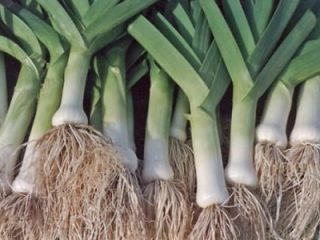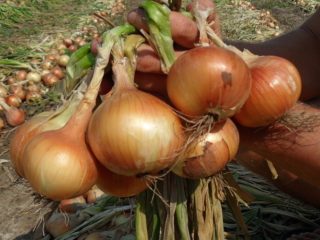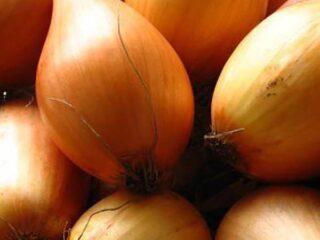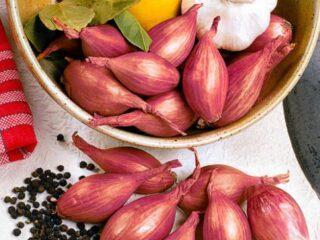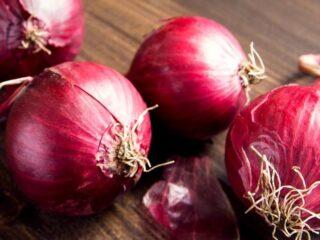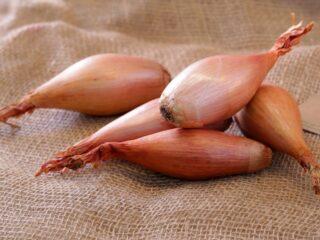Content
Watering onions from worms is carried out with chemicals, and during fruiting - with biological and folk remedies. If there are too many pests, you should use the most powerful insecticides and acaricides. A description of the main pests and methods of their destruction are presented in the article.
Reasons for the appearance of worms in onions
If worms have appeared in the onion or directly in the root crop, the causes of the invasion may be associated with various factors:
- no digging in the fall;
- the bulb was not disinfected;
- there is no alternation of onion and carrot beds.
- violation of crop rotation (the plant is grown for several years in a row in one place).
Types of worms and symptoms of damage
There are quite a few types of worms that eat onions. They belong to different classes, including insects, mites and worms. The main types of pests and a description of the symptoms of damage are presented below.
Onion fly larva
This is one of the common, very dangerous pests.If white worms with a “dirty” tint and only 1-2 mm long appear in the onion, these are onion fly larvae. Adults reach 8 mm and have yellow, oblong wings. The body color is gray, close to ash.

Pests lay eggs on seedlings and in the surface layer of soil
The larvae emerge from these eggs within 4-6 days. They move into the rhizome and feed on them. Main signs of invasion:
- mass plantings wither even when the first leaf appears;
- dirty white larvae visible on the soil surface;
- worms also appear in green onions - small holes are noticeable in the feathers, as well as in the turnips;
- the roots begin to rot.
Wireworm
The wireworm is the larva of the click beetle. This is another worm that attacks onions, so even at the beginning of the invasion it is necessary to water the plantings with preparations. The development cycle is long, taking several years. All this time the worms are in the soil, they do not come to the surface and at the same time constantly infect the plantings. This is noticeable by the following signs:
- the stems dry out;
- holes appear in the bulbs;
- plants lag behind in development and look sluggish.
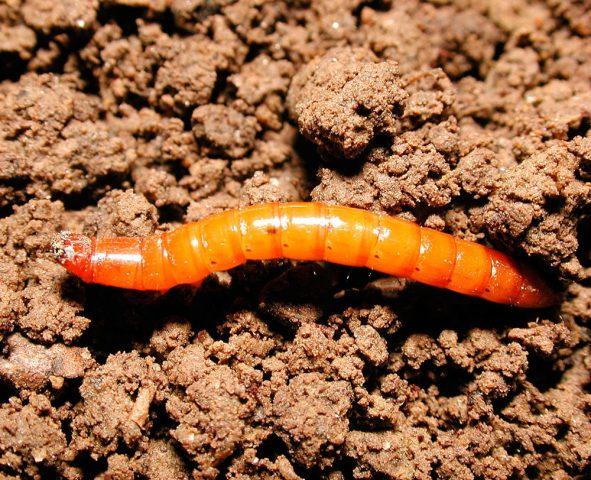
If signs of wireworms are detected, it is necessary to immediately water the plantings with chemicals.
Onion nematode
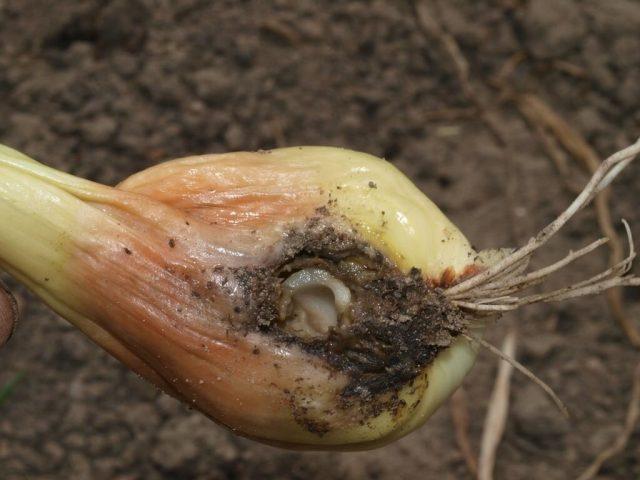
If there is a white worm in the onion, it could be a nematode
This is a dangerous pest that can destroy plantings in just a few days. The body is small, up to 1.5-2 mm in length. The color is white with a yellowish tint. It feeds on plant tissues and lays eggs in it.Then, after 3-5 days, larvae appear from them, which cannot be seen with the naked eye.
Plants should be watered with chemicals or other means at the first symptoms:
- the bulbs soften;
- feathers dry out and turn yellow;
- rhizomes rot;
- roots (from the bottom) and husks fall off;
- the lower part of the stem rots;
- the surface of the heads cracks.
Thrips
A very dangerous pest that affects not only onion plantings, but also the harvest after harvest (in the basement, cellar, and other rooms). It is a small worm growing up to 1.3 mm. The color is brown or dirty yellow, with red eyes. The eggs are white and resemble barrels. Thrips lay eggs in onion stems, so you should water both the root and the green part.
The invasion of this type of worm can be determined by the following signs:
- onions lose growth;
- the stems turn yellow and change shape;
- seedlings begin to rot quickly;
- stripes of white or silver color are noticeable on the foliage;
- the bulbs become smaller.

A characteristic feature of the pest is high fertility
It produces a second generation after three weeks. Therefore, it should be watered with special solutions several times during the spring and summer.
Root mite
Another pest that resembles a worm. It attacks onions and feeds on the pulp of the root crop, causing the latter to rot. The danger is associated with both damage to plantings and already harvested crops. Root mites are barely noticeable - the bodies are 1.0-1.1 mm long, the color is white, sometimes yellow.
They lay eggs (oval shape, white color) directly into the roots of the onion. Therefore, you need to water thoroughly so that the solution penetrates deeply into the soil. Larvae form after 15-20 days.During cold weather, worms may hibernate, but with the return of warmth they become active again.
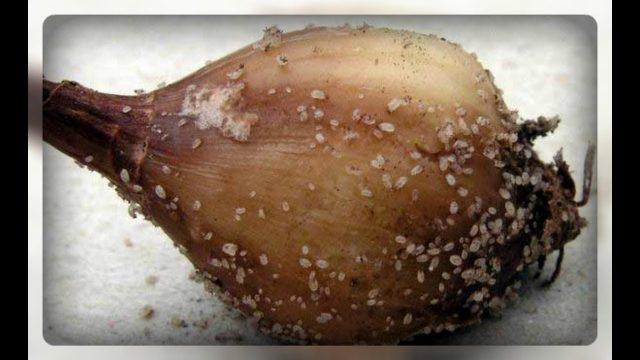
A bulb affected by a root mite quickly rots
You should water at the first signs of an invasion:
- white coating on foliage;
- drying, yellowing of feathers;
- loss of normal shape of the heads;
- rot, mold on the roots, stems;
- roots falling off the bottom (they die).
Onion weevil

Among the worms that harm onions, the weevil is dangerous.
It feeds on the juices of the stem, which is why the head stops developing. Adults reach a length of 3 mm, are black in color, and have a noticeable longitudinal stripe along the back.
Already in early May, pests lay white eggs in onion foliage. At this point, the plantings should be watered using folk remedies or special preparations. Treatment is intensified when obvious signs of invasion appear:
- onions stop growing;
- the arrows turn yellow and fade;
- irregularities are noticeable along the edges of the leaves;
- White spots appear on the stems.
Onion hoverfly
This worm reaches no more than 7 mm in length. It has a greenish color with a hint of bronze and 2 stripes along the back of gray color. Outwardly it resembles a fly. In early May, hoverflies penetrate the surface layer of soil and lay eggs, including near onions. After 7-10 days, worms will hatch from them - larvae of a white, dirty color. They begin to feed on pulp, then move back to the soil for the winter.
It is necessary to water plants and soil with insecticides when the following signs appear:
- the stems wither and turn yellow;
- plants stop developing;
- the head softens, its middle turns black;
- Due to the rotting of the onions, an unpleasant smell comes from the garden.
Onion moth
This is a dangerous pest that feeds on onion stems and roots, leading to loss of yield. Mature individuals are small butterflies (up to 1.5 mm) of a brown hue. Already in May, they lay yellow eggs in the onion stems, and a week later worms hatch from them - larvae up to 1 cm long. Numerous brown warts are noticeable on the surface.
Plants need to be watered at the moment when the first signs of invasion begin to appear:
- onions stop growing;
- leaves fade;
- the bulbs rot;
- longitudinal stripes are visible on the stems;
- the arrows turn yellow and fade.
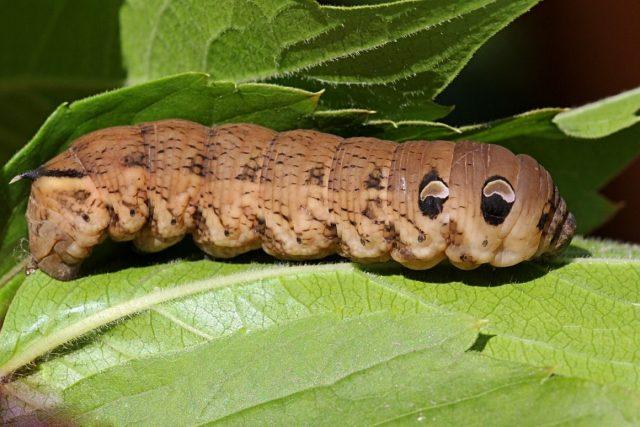
Onion moth caterpillar
How to get rid of worms in onions
If there are worms on the roots or in the onion greens, you need to start fighting them as quickly as possible. Almost all pests are prolific, producing several generations per season. Therefore, if nothing is done, a significant part of the harvest will be lost.
To destroy worms, plantings need to be watered with different solutions. The most effective remedy is chemicals. But they are unsafe during the fruiting period. Therefore, along with chemical insecticides, biological preparations and folk remedies are also used. The main options are described in the following sections.
Chemicals
Chemicals (insecticides, acaricides) are the best means of killing worms. The active ingredients are highly toxic, so one treatment is usually sufficient. To save onions from pest invasion, they should be watered with the following chemicals:
- "Fly-eater";
- "Medvetox"
- "Zemlin."
These products are applied directly to the soil, i.e. you need to water the beds, and for prevention, the row spacing. Onions are also treated against worms with other insecticides (the leaves are sprayed with them):
- "Iskra DE";
- "Fitoverm";
- "Soil."
Biological drugs
Unlike chemicals, biological preparations contain strains of bacteria and other microorganisms that destroy worms. Onions should be watered with such solutions at the fruiting stage, when it is no longer possible to use chemicals, and folk remedies are not effective enough.
The most effective biological insecticides and acaricides include:
- "Trichodermin";
- "Metronidazole";
- "Bitoxibacillin."
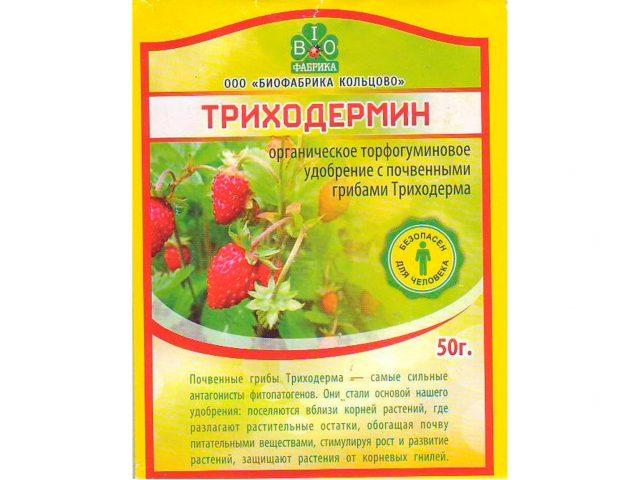
"Trichodermin" works as an insecticide and as a bacterial fertilizer
To water onions against worms, the preparations are diluted according to the instructions, strictly observing the dosage. It is important to take into account the waiting times - they are quite short and amount to only a few days.
Folk remedies
You can also treat onions against worms using folk remedies. They are indispensable when fruiting has already begun or the crop is grown for greens. The fact is that many chemicals are toxic, and waiting 20-30 days from the last watering (waiting period) is not always possible. In addition, folk remedies help to cope quite well in the early stages of the invasion.
It is recommended to water onions against worms with solutions and infusions prepared according to the following recipes (amount given per 10 liters):
- Take 100-150 g of wood ash (vegetable ash will not work) and dissolve it in the specified volume. They insist a little and begin to water the plants to remove the worms.
- Collect dandelion flowers (yellow), take 200 g and infuse in 1 liter of water at room temperature for two days. Dilute the water in a bucket, filter and begin to water the onions to remove the worms.
- Another proven remedy is to get 200 fine shavings of laundry soap, dissolve it in warm water, mix and start processing.
- You can also water the onions to remove worms with a solution of regular table salt (300 g per bucket). But the procedure can be repeated no more than twice per season.
Preventive measures
Getting rid of onion worms is sometimes much more difficult than preventing their invasion. To do this, you need not only to water the plants with different means, but also to follow other rules of agricultural technology:
- Crop rotation.
- Dressing onion sets.
- Disinfection of soil for seedlings.
- Compliance with watering norms.
- Planting marigolds, anise, dill and other plants with a fragrant aroma next to the beds.
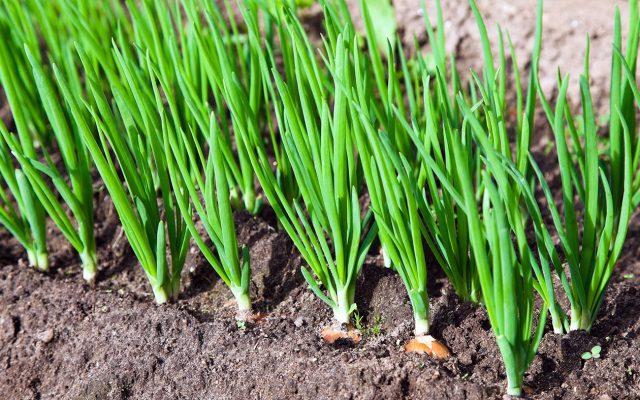
To prevent invasion, onions should not be planted in one place for more than three years in a row.
Conclusion
Watering onions from worms is carried out after the emergence of mass shoots, and then as needed. If an invasion is observed during the fruiting period, it is recommended to use only biological preparations and folk remedies. In any case, the harvest can be harvested no earlier than three days after the last spraying.
